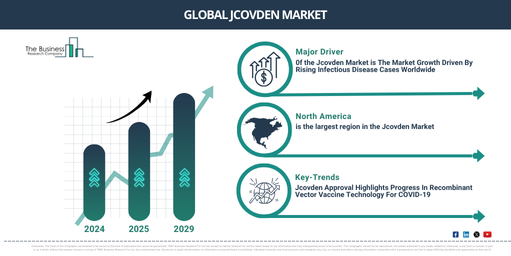Protein Labeling Market Valuation Expected To Reach $4.36 Billion By 2029, Growing At A Rate Of 11.3%
Discover trends, market shifts, and competitive outlooks for the protein labeling industry through 2025-2034 with The Business Research Company’s reliable data and in-depth research
#How Has The Protein Labeling Market Growth Evolved From 2024 To 2025, And What’s Ahead?#_x000D_
The market size for protein labeling has seen swift expansion in the last few years. The market is predicted to rise from $2.58 billion in 2024 to $2.84 billion in 2025, recording a compound annual growth rate (CAGR) of 10.1%. The historical growth has been propelled by a rising demand for protein-centric therapeutics, the increasing use of proteomics research, a widening application scope for protein labeling, a growing understanding of protein labeling’s advantages, a rise in the supply of qualified workforce, and an increasing incidence of chronic ailments._x000D_
_x000D_
In the upcoming years, it is projected that the protein labeling market will experience swift expansion. The market valuation is speculated to reach $4.36 billion in 2029, with an 11.3% compound annual growth rate (CAGR). The projected growth during the forecast period is driven by factors such as the prevalence of personalized medicine, point-of-care (POC) testing, the expansion of proteomics, augmented funding and investment in life science research, and increasing healthcare spending. Key trends anticipated during the forecast period encompass advancements in protein labeling technologies, the use of quantum dots and nanoparticles, multiplexing and high-throughput labeling, biorthogonal labeling, incorporation of artificial intelligence (ai), sustainable labeling reagents and drug development._x000D_
_x000D_
#Download a free sample to assess the report’s scope and structure:#_x000D_
https://www.thebusinessresearchcompany.com/sample.aspx?id=3417&type=smp_x000D_
_x000D_
#Which Factors and External Forces Are Driving Demand in the Protein Labeling Market?#_x000D_
The growth of the protein labeling reagents market is being propelled by a rise in spending on genomics and proteomics R&D. Proteomics, which is the comprehensive study of a cell, tissue or organism’s protein content, necessitates the use of protein labeling methods prior to separation and analysis in proteomic profiling techniques. For example, the National Institutes of Health (NIH) in the US allocated $37 billion towards biomedical research funding. This financial support is dedicated to life sciences research conducted at the molecular level, aiming to comprehend the basic processes through which diseases emerge, identify biomarkers that indicate the existence of a disease, or find out the genes or proteins causing the disease. The University of Copenhagen was awarded up to $1.5 million by the Novo Nordisk Foundation to create a mass spectrometry department, symbolizing a new and thrilling phase in protein research. Consequently, the surge in spending for proteomics and genomics research and development is pushing the market forward._x000D_
_x000D_
#Which Segments in the Protein Labeling Offer the Most Growth?#_x000D_
The protein labeling market covered in this report is segmented –_x000D_
_x000D_
1) By Product: Reagents, Protein, Enzymes, Probes/ Tags, Monoclonal Antibodies_x000D_
2) By Labeling Method: In-vitro Labeling, In-vivo Labeling_x000D_
3) By Application: Cell Based-Assay, Fluorescence Microscopy, Immunological Techniques, Mass Spectrometry, Protein Micro Assay_x000D_
_x000D_
Subsegments:_x000D_
1) By Reagents: Fluorescent Dyes, Enzyme Labels, Chemiluminescent Reagents, Radioactive Labels_x000D_
2) By Protein: Recombinant Proteins, Native Proteins, Modified Proteins_x000D_
3) By Enzymes: Alkaline Phosphatase, Horseradish Peroxidase, Other Enzymatic Labels_x000D_
4) By Probes Or Tags: Biotin Labels, Antibody Tags, Fluorophore Probes, Affinity Tags_x000D_
5) By Monoclonal Antibodies: Primary Monoclonal Antibodies, Secondary Monoclonal Antibodies, Conjugated Monoclonal Antibodies_x000D_
_x000D_
#Request customized data on this market:#_x000D_
https://www.thebusinessresearchcompany.com/customise?id=3417&type=smp_x000D_
_x000D_
#What Are the Fastest-Growing Geographies in the Protein Labeling Market?#_x000D_
The countries covered in the protein labeling market report are Australia, Brazil, China, France, Germany, India, Indonesia, Japan, Russia, South Korea, UK, USA, Italy, Spain, Canada._x000D_
_x000D_
#Which Cutting-Edge Market Trends Are Expected to Drive the Protein Labeling Market’s Growth?#_x000D_
The market may be impeded by the disadvantages associated with protein labeling methods. There is a tendency to favor label-free techniques over labeled ones due to certain issues like the complexity of the wet lab and lack of adaptability. Unlike labeled samples which require elaborate wet lab preconditions, label-free samples require minimal preparation. Labeling techniques necessitate the use of either metabolic (like SILAC) or chemical (like iTRAQ or TMT) reagents, and the combination of various conditions. This increases their susceptibility to errors in the wet lab compared to label-free techniques. Furthermore, label-free methods boast high adaptability, even after the onset of the study. They can accommodate new samples into the study at any time, unlike labeled techniques that need a consistent number of each condition. Labeled techniques make it impossible to incorporate new samples if they can’t be physically combined and measured with the control. Super-SILAC, a labeled technique, mitigates this issue but needs meticulous planning. Due to these reasons, label-free methods are more preferred, which is why the handicap associated with protein labeling techniques could potentially obstruct the market._x000D_
_x000D_
#View the full report here:#_x000D_
https://www.thebusinessresearchcompany.com/report/protein-labelings-global-market-report_x000D_
_x000D_
#What Are the Key Elements That Define the Protein Labeling Market?#_x000D_
Protein labelling refers to the process of detecting or purifying the labelled protein and its binding partners by using the proper molecular labels. Most biological research uses one of three basic categories of protein labels: biotin, enzyme conjugates, or fluorescence probes._x000D_
_x000D_
#Purchase the full report and get a swift delivery:#_x000D_
https://www.thebusinessresearchcompany.com/purchaseoptions.aspx?id=3417_x000D_
_x000D_
#About The Business Research Company:#_x000D_
With over 15000+ reports from 27 industries covering 60+ geographies, The Business Research Company has built a reputation for offering comprehensive, data-rich research and insights. Armed with 1,500,000 datasets, the optimistic contribution of in-depth secondary research, and unique insights from industry leaders, you can get the information you need to stay ahead in the game._x000D_
_x000D_
#Get in touch with us:#_x000D_
The Business Research Company: https://www.thebusinessresearchcompany.com/_x000D_
Americas +1 3156230293_x000D_
Asia +44 2071930708_x000D_
Europe +44 2071930708_x000D_
Email us at info@tbrc.info_x000D_
_x000D_
#Follow us on:#_x000D_
_x000D_
LinkedIn: https://in.linkedin.com/company/the-business-research-company_x000D_
YouTube: https://www.youtube.com/channel/UC24_fI0rV8cR5DxlCpgmyFQ_x000D_
Global Market Model: https://www.thebusinessresearchcompany.com/global-market-model



